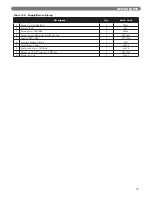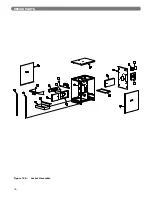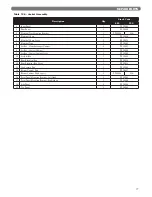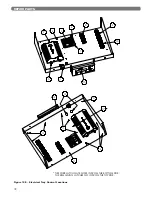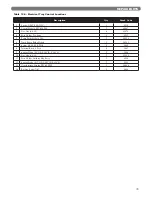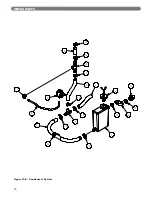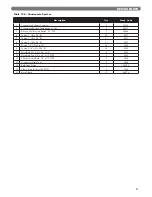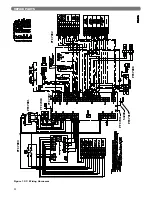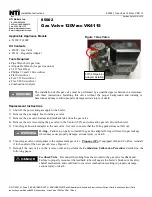
67
MAINTENANCE
d. Attach the drain hose to the outlet of the system.
e. Connect the wires to the blocked condensate
float switch in the lid of the condensate
container.
f. Fill the condensate container with 1-2 inches of
water.
4. Restarting the Boiler:
a. Open the manual gas valve at the rear of the
boiler.
b. Turn the burner service switch on.
c. Observe the boiler function to make sure you see
condensate flow.
d. If no flow of condensate is evident, repeat this
procedure.
5. If the problem persists it is possible that there
is a problem with material deposits in the heat
exchanger. Follow the Combustion Chamber Coil
Cleaning Instructions in this section.
E. COMBUSTION CHAMBER COIL
CLEANING INSTRUCTIONS
Before beginning this procedure, you must have on
hand the following items:
– a nylon or plastic brush (not steel or any other
metal)
– “Rydlyme” (recommended for best results)
(available online www.rydlyme.com) or “CLR”
(available at most hardware stores)
1. Shut the boiler down and access the heat exchanger
using the following steps:
a. Close the manual gas shutoff valve and wait for
the unit to be cool to the touch.
b. Disconnect the condensate piping from the
outside connections (not from the Series PFC
TM
side) so the flow can be observed.
c. Remove the (4) 1/4-20 bolts from the venturi to
air filter box.
d. Disconnect union joint on gas inlet and
disconnect the gas valve electrical connections.
e. Remove the six 10 mm Allen bolts from the
burner plate assembly. Disconnect wire leads
to the spark igniter, flame sensor, and igniter
ground. Disconnect one Molex (1x5) plug and
one MatnLok (1x3) plug from blower motor.
f. Pull the entire burner plate towards you to access
the heat exchanger coils. It is heavy.
2. Using a spray bottle filled with the recommended
product “Rydlyme” or “CLR”, spray liberally on
the coils, making sure the solution penetrates and
funnels down through the condensate hose. If
the condensate hose is blocked, let the chemical
penetrate for at least 15 minutes or until it drains.
3. Use the nylon or plastic brush (not steel or any other
metal) and scrub coils to remove any buildup, then
vacuum the debris from the coils.
4. Spray coils with clear water, making sure to confine
the spray to the area being cleaned (try to avoid
wetting the back ceramic wall of the unit). Flush the
combustion chamber with fresh water. At this point,
the Series PFC
TM
should be ready to power back up.
5. Reinstall the burner plate assembly using the
following steps:
a. Inspect the inside of the heat exchanger for dirt
and debris.
b. Confirm ignitor and sensor gap dimensions.
Sensor location is 7/16” (12mm) off of the
burner. Igniter location is 8mm off of the burner
with a gap of 3/16” (4.5mm) between the
electrodes.
c. Install the burner plate assembly and replace the
six 10 mm Allen nuts. Application of an anti-seize
compound is optional but recommended.
d. Reconnect the wire leads to the spark igniter,
flame sensor and gas valve. (Be sure that the
spark igniter is connected to the lead with the
large insulated connection boot.) Reconnect two
Molex plugs on blower motor.
e. Connect the union on the gas header and
reattached the gas valve electrical connector.
f. Reinstall the (4) 1/4-20 bolts connecting the
venturi to the air filter box.
g. Reset thermostats.
(IMPORTANT: BE SURE
THAT THE VENT CONNECTION IS NOT
BLOCKED.)
h. Turn the power to the Series PFC
TM
on. Observe
the display module to assure proper operation.
i. Initiate a call for heat** and observe the
condensate flow.
j. Reconnect the condensate piping to the drain
connection.
**NOTE: When firing the boiler the first
few times you may experience some
fluttering of the gas burner that may result
in a flame lockout. This is normal and will
require you to recycle the unit until this
clears up. This is caused by water still
present in the combustion chamber.
6. Inspect exhaust vent and air intake vents for proper
support and joint integrity. Repair as necessary. Refer
to Section 5, VENTING.
7. Inspect exhaust vent and air intake vent terminations
for obstructions or corrosion. Corrosion is an
indication of exhaust gas recirculation.
It is extremely important to check for leaks when
reconnecting the gas valve. Failure to do so may
result in severe personal injury, death or major
property damage.
WARNING
Leaks in the vent system will cause products of
combustion to enter structure (vent system operates
under positive pressure).
WARNING























